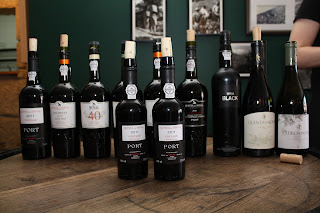Benfica and
Port. I like both of them, and recently I had the opportunity to experience the
combination. No, I was not drinking port at Estádio da Luz… I tasted a Port
wine released as a tribute to the legend of football, Eusébio, when he turned
70 last year.
 The Black
Panther, as Eusébio was nicknamed, was born in
The Black
Panther, as Eusébio was nicknamed, was born in
During
Estado Nova, Salazar decided that the colonies were overseas provinces, and
because of that Eusébio could join the Portuguese national team in 1961. During
the following years he scored 41 goals in 64 matches for the team. Most
legendary was the 1966 World Cup in England ,
where Portugal ended as 3rd.
Eusébio was the top scorer of the tournament with 9 goals, and 4 of them in the
match against North Korea Portugal was behind 0-3, but
the final result was 5-3 to Portugal
The legend
still visits Estádio da Luz, when Benfica is playing, and there is a statue of
him in front of the entrance.
At a
tasting in The Vintage Port Club his profile and his signature was on the label
of one of the bottles of Port on the menu.
”Eusébio 70th”
is a 30 years Tawny from Quinta das Gregocas, near Sambrosa in the Douro . They released exactly 638 Magnums – one for each
goal he made for Benfica!
The Port
wine was light red brown, some spirit in the nose, dry fruits, floral notes and
notes from the oak as well. It was not that powerful and did not have a broad
palette compared with others 30 years Tawnies. Drinkable, but I must admit that
the history behind and the nice design was more exciting that the port itself.
The tasting
was the clubs Christmas tasting, where we usual have Tawny and Colheitas. Here
is the full list as they were served:
Maynard
Colheita 1982
Feist
Colheita 1983
Vista
Alegre 30 years Tawny
Kopke
Colheita 1984
Kopke 40 years
Tawny
Pocas 40 years
Tawny
Grahams 40 years
Tawny
Andresen 40
years Tawny
Burmester
Colheita 1957
Quinta das
Gregocas Eusébio 70th
Cristiano
van Zellers Millennium Port
Feuerheerd Colheita 1990
The best
wines in my opinion were Maynard 1982, Kopke 1984, Kopke 40 years, Burmester
1957 and the Millennium
Port.


























